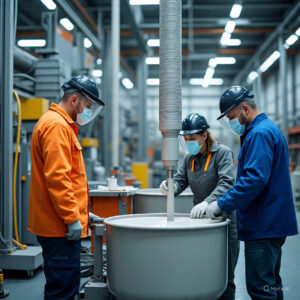High-Solid Coatings: Doing More with Less Solvent

For decades industry has been relying on high solvent-based solutions at a high cost, whereas today, high-solid coatings are rewriting the equation with higher resin content and lower VOC emissions.
High coatings contain more resins, which are solid and have less solvent than traditional paint. It helps to allow a thicker protective layer, reduces emissions, and requires fewer coats, making them ideal for industrial and infrastructure projects where performance, speed, and compliance are the thing that matters.
High-solids coating typically has 60-80% solids vs. the traditional coating with 30-50%. VOCs have lower content due to reduced solvent use. It delivers higher dry film thickness (DFT) in a single coat.
Advantages of High-Solid Coatings:
- Has lower VOC emission, which make it easier regulatory compliance
- Very fewer coats needed as it has faster project turnaround and lower labor cost
- Provides better protection due to high film build resists corrosion, abrasion, and weather
- It has less solvent which make it safer for work environment and reduces the chance to catch fire
- Has high transfer efficiency as it less overspray and reduce material waste
To start something new without challenge it feels incomplete, here comes the challenges and strategy to follow to avoid it:
- Higher Viscosity which can be solved by the needs airless or heated spray system
- Shorter pot life require trained applicators and fast execution
- Substrate cleanliness critical can solved by following the surface prep of SSPC/NACE standards
- Cost per liter may be higher but total lifecycle cost is lower due to longevity and fewer coats
What are the Procurement and Lifecycle cost perspective?
- Upfront cost is higher by 10-20%
- As it reduces the application time up to 40%
- It extends recoat cycle to 10+ years in marine, oil and Gas
In high-solid coating we definitely pay more per liter, but we coat less often and it saves millions of unplanned shutdown
Market Growth Insight Data:
- Global high- solid coatings market are projecting to grow between 5-7% CAGR by 2030
- It has stricter environmental regulations
- There is rising steel infrastructure project
- There is demand of long lasting marine and offshore coatings
Types of high-solid coating:
- High-solid epoxies – It is for tanks, marine hulls and steel
- High-solid polyurethanes – topcoats for gloss/UV resistance
- High-solid Acrylics – general metal and industrial
- Isocyanate-free systems – safer polyurethane alternatives – High-solid coating could be expensive initially but it reduces your all hidden cost. Just one application and it will make an unforgettable and will keep your industry name in minds. Just one swap all it takes!
For more such latest updates and news visit Industrial Front
